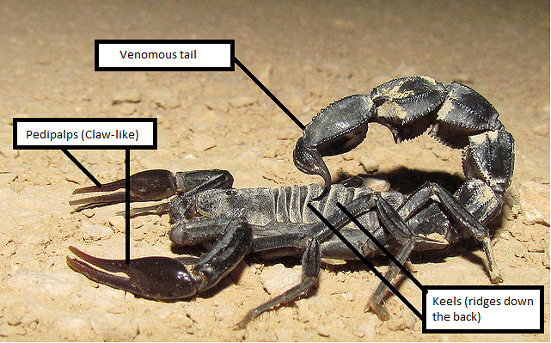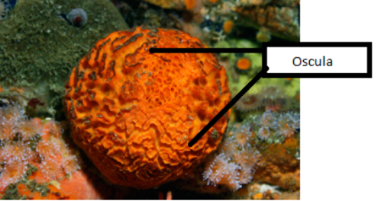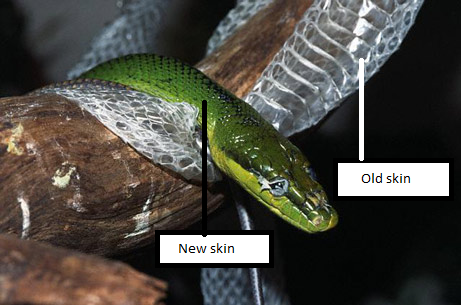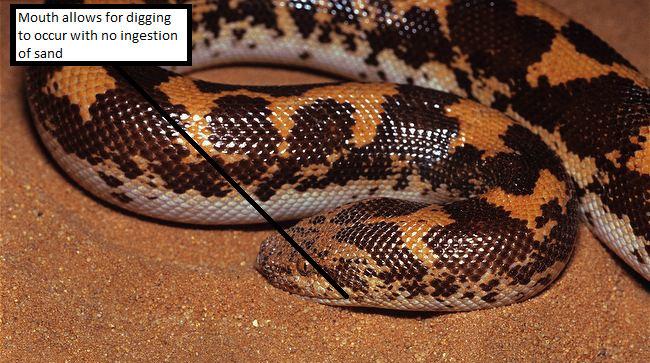DOMAIN • THREE
•KINgDOM animalia•
Common name- Arabian Fat Tailed Scorpion
Domain: Eukarya
Kingdom: Animalia
Phylum: Arthropoda
Class: Arachnida
Order: Scorpiones
Family: Buthidae
Genus: Androctonus
Species: crassicauda

Figure 6b: Arabian Fat Tailed Scorpion
This image shows the venomous tail, the keels, and the claw-like structures used to catch prey and defend.
Androctonus crassicauda is a multicellular prokaryoticscorpion found in the Middle East, mostly in the Arabian Peninsula and Egypt, thus the common name of Arabian Fat Tailed Scorpion. This animal has a very large and strong tail with the ability to inject a lethal venom. Along with its tail, it has claw like structures, called pedipalps, which are used as a defense mechanism and as a way of catching and retaining prey. The tail and claws have setae which are tiny hair sensors. The Arabian fat tailed scorpion moves by walking on eight legs. Red and brown are the most common colors, however, some scorpions may be a little more black than brown. Down the middle of the scorpion’s back, ridges can be found making the texture of the scorpion look a little rougher. It is about 8 to 10 cm in length, and it has a nervous system. This species usually lives in a desert environment with minimal amounts of rain or snow. During the day it lives in burrows. During the night, it travels freely in the desert. It is a nocturnal predator which means it only comes out to find food, at night. It eats other animals such as insects and spiders. Reproduction occurs sexually by the combination of gametes. The litter size is around 35. They live on their mother’s back for several days [10b].
Why this belongs in this Domain:
This animal belongs in this kingdom, Animalia, for several reasons. Firstly, the male scorpions mate with the females which results in sexual reproduction, meiosis. Second, this organism does have a nervous system and is motile. Finally, it is eukaryotic which explains why it belongs in domain Eukarya. It belongs in the phylum Arthropoda because it has appendages. For example, it has a venomous tail. Due to the fact that it has eight legs, it belongs in the class Arachnida. Having eight legs, a huge tail, pedipalps, and being a predator qualify it for the order Scorpiones. However, it does not belong in the domains Bacteria or Archaea because it does not use flagella or cilia to moveand does not have prokaryotic cells.
Common name- Orange Puffball Sponge
Domain: Eukarya
Kingdom: Animalia
Phylum: Porifera
Class: Demospongiae
Order: Hadromerida
Family: Tethyidae
Genus: Tethya
Species: aurantium

Figure 7b: Orange Puffball Sponge
This image shows an adult Orange Puffball Sponge and its larger openings called oscula in which water and waste exit the organism.
The Orange Puffball Sponge, Tethya aurantium, is a eukaryotic, multicellular organism. It has a rough outer surface with a flat bottom and an orange-yellow color. It is about 20 centimeters in diameter. On its body surface, tiny pores called ostia can be found. These ostia allow small particles of food and oxygen carried by water to enter the sponge. This sponge has flagella that move the water surrounding the organism in order to keep the oxygen flowing through the ostia. Its diet includes bacteria, small particles, and organic matter that have been dissolved. Water and waste exit the puffball by several larger openings called oscula. Spongin, a structural protein and little sharp pieces called spicules create a matrix that supports the body of the sponge. The spicules are used when a part of the sponge becomes infected. When a part of the body is infected, the spicules isolate that part and cut it off and then the body is able to regenerate the lost part of the body. This animal is not known as a predator and it serves as food for many other sea animals. Once Orange Puffball Sponges become adults, they lose their ability to move around. Although they cannot swim away from predators, they defend themselves by releasing a chemical that scares away the predator. They are able to do this due to the presence of a nervous system. It can reproduce sexually or asexually. The sponge can be found in certain parts of southeastern Alaska and California [11b].
Why this belongs in this Domain:
The Orange Puffball Sponge is eukaryotic and an animal which means it belongs in domain Eukarya and kingdom Animalia. It belongs in the phylum Porifera as this phylum only contains sponges. Due to the fact that this particular sponge has a skeleton made out of spicules and spongin, this animal belongs to the class Demospongiae. Lastly, it belongs to the genus Tethya because it has a spherical body which is the shape of sponges in this genus. It does not belong in the domains Archaea and Bacteria. All of the organisms in domain Archaea are unicellular however, this animal is multicellular. This organism does not belong in domain Bacteria because the Orange Puffball Sponge is eukaryotic and all the organisms in domain Bacteria are prokaryotic.
Common name- Kenyan Sand Boa
Domain: Eukarya
Kingdom: Animalia
Phylum: Chordata
Class: Reptilia
Order: Squamata
Family: Boidae
Genus: Gongylophis
Species: colubrinus

Figure 8b: Snake shedding its skin
In this picture, a snake is molting its skin. It has grown too big for its skin so it has to start new. Due to the fact that the snakes have an exoskeleton, they must shed it every time they grow. Their exoskeleton is made up of dead cells, which makes it impossible for the exoskeleton to grow with the snake, therefore the snake must shed the skin and replace it with new skin.

Figure 9b: Kenyan Sand Boa
This image shows a Kenyan Sand Boa in its natural habitat, the sand.
An animal found in Kenya and other East African countries is the Gongylophis colubrinus, the Kenyan Sand Boa. They live buried in the sand of the desert and can live for over twenty years. Colors of this animal vary. They reproduce sexually however, females are generally much larger than male sand boas. This is due to their need to carry fetuses and give birth to baby sand boas. Males usually measure about two feet in length while a female boa measures about three feet long and has a heavier body. Although one gender is larger than the other, they do share most of the same adaptations. Their mouths are shaped and positioned in a way that allows them to dig into the sand without ingesting the sand and they both contain nervous systems. The back of their tails have keeled (ridges) scales that give them more traction in the soft sand. These boas usually only eat once a week and they eat dead mice [12b]. Due to the fact that snakes have exoskeletons, they molt. This means that the snake sheds its skin once or twice a month as it continues to grow. A snake’s skin does not grow with the animal as a human’s skin does. Therefore, when a snake outgrows its skin, it molts and starts new with a fresh and bigger layer of skin. If a snake is unable to shed its skin, problems can occur. Accumulation of unshed skin near the eyes could cause blindness and lack of hydration from humidity could lead to the skin sticking to the body. This snake is a multicellular eukaryotic organism that moves by slithering across the surface of the sand [13b].
Why this belongs in this Domain:
Becausethis snake is an animal and is eukaryotic it belongs in the kingdom Animalia and the domain Eukarya. Chordata is the correct phylum because this snake has a notochord which is a rod like chord of cells which shapes the body. The animals in the class Reptilia include turtles, lizards, crocodiles, and snakes (the Kenyan Sand Boa). Since this snake has scales, it belongs in the order Squamata which only contains scaled reptiles. Being a non-venomous snake puts this animal in the family Boidae. Although it doesn’t use feet to move, it doesn’t use flagella or cilia which means this animal does not belong in either domain Archaea or domain Bacteria. Another reason why it doesn’t belong in the other domains is because it reproduces sexually rather than asexually, and because it does not contain prokaryotic cells.
Answer the following questions based on the paragraphs above.
RJ